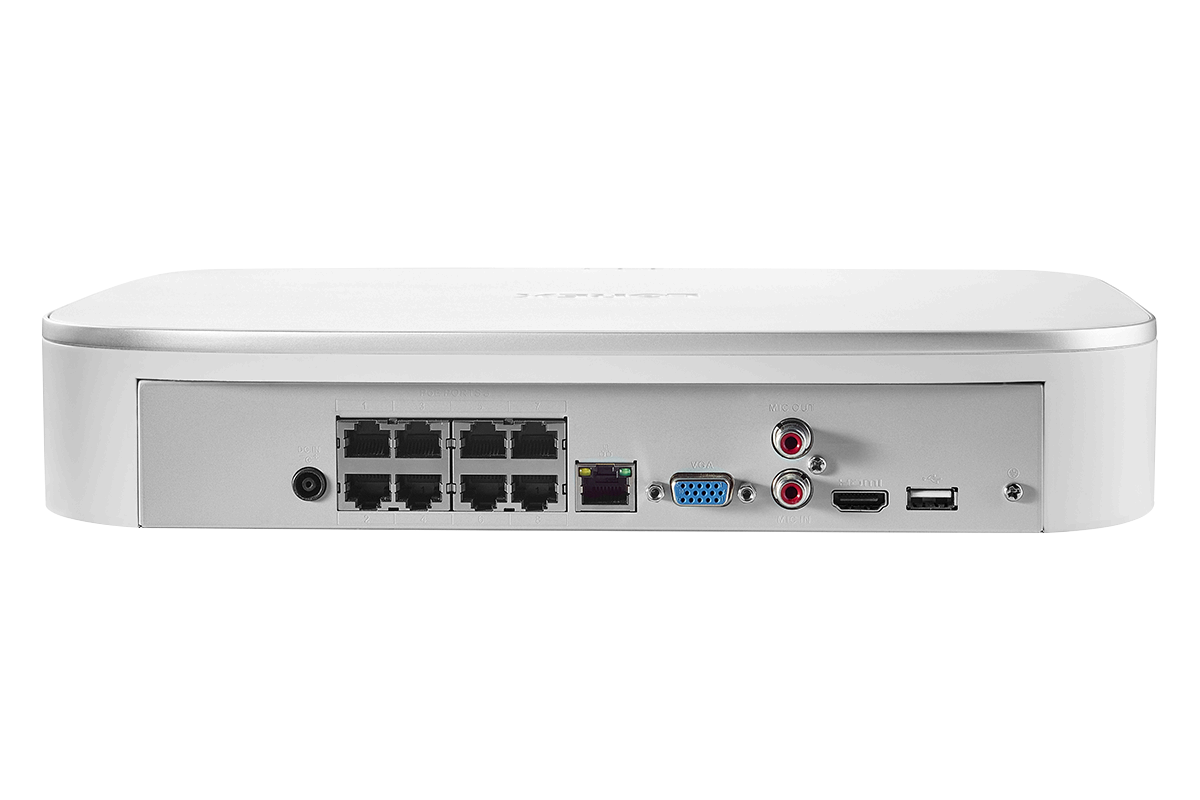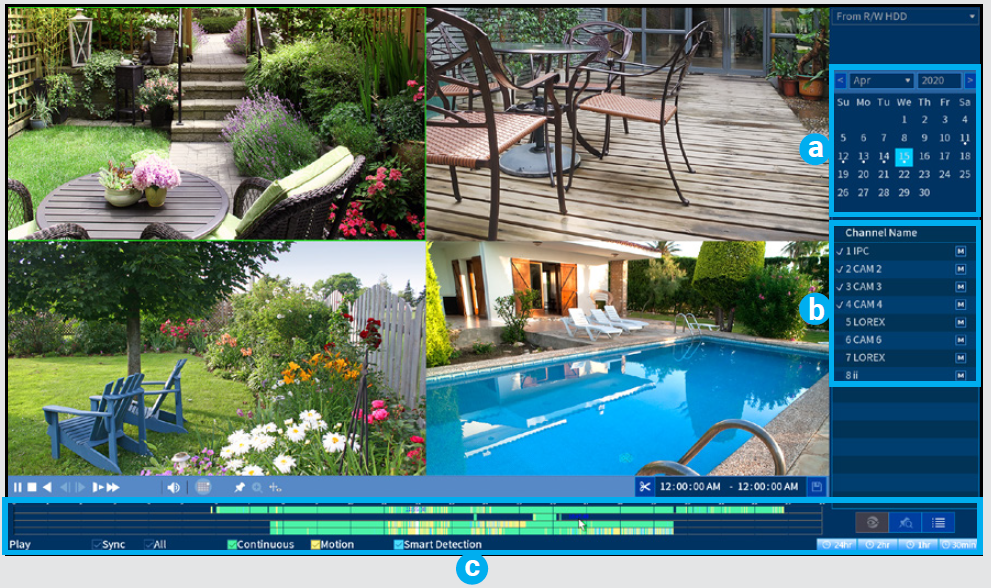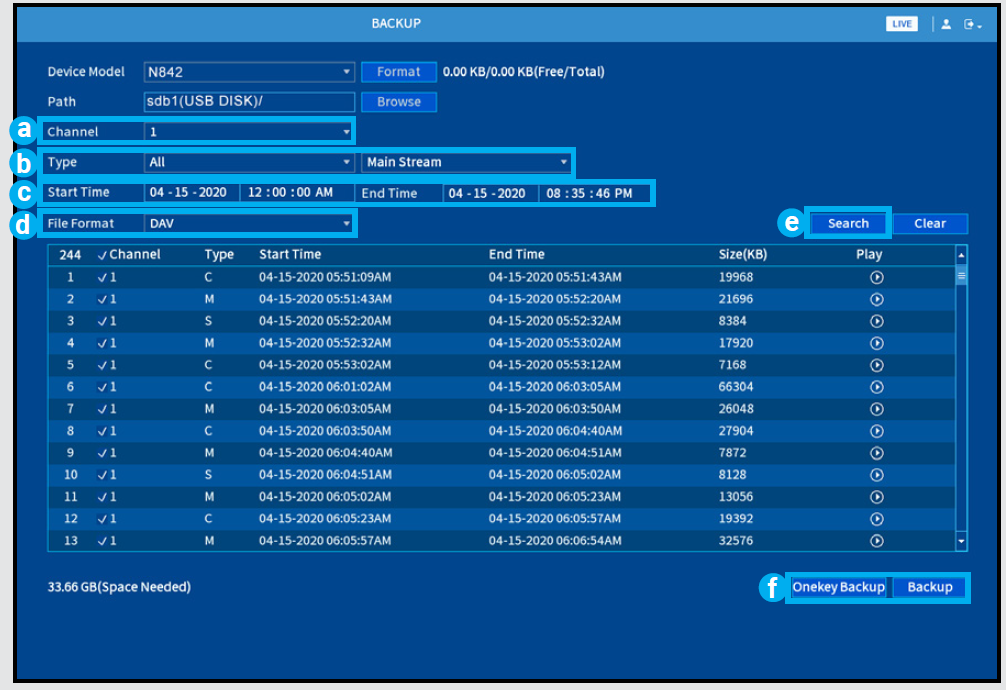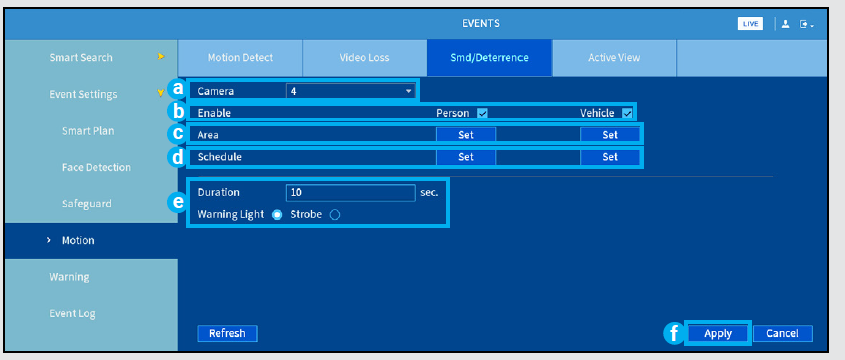LOREX N841 Series 4K 8-Channel Fusion Series Network Video Recorder

Package Contents
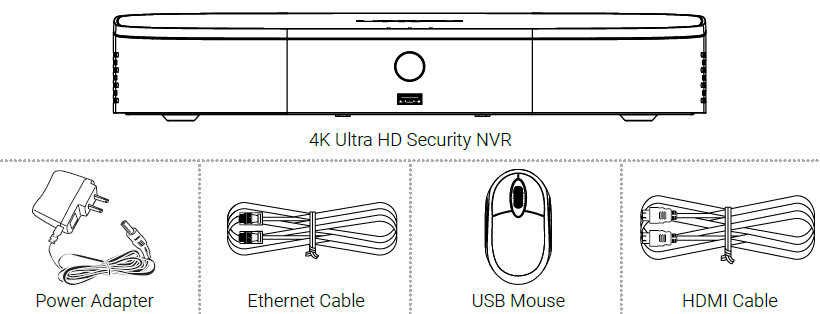
Dimensions

Setting Up Your Recorder
See the steps below (expanded instructions to the right) to complete initial setup of the recorder:
Overview of extra ports:

Back panels shown below are for illustration only. Your recorder’s back panel may appear different, with all the same in different locations.
STEP 1: Connect cameras
Test your cameras prior to selecting a permanent mounting location by temporarily connecting the cameras and cables to your NVR using one of the following 2 methods: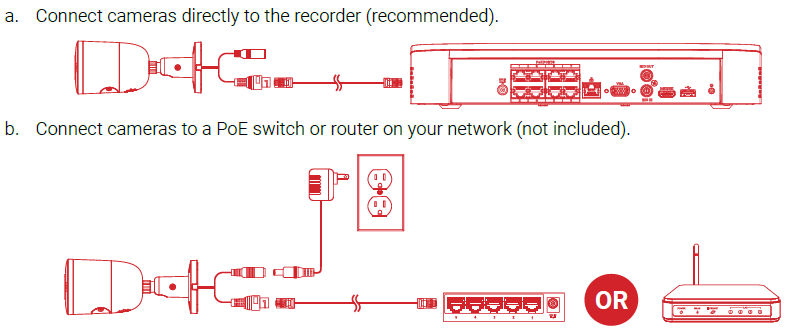
NOTES:
- It may take up to 1 minute for cameras to start up and transmit video to your recorder.
- This guide covers connecting IP cameras to your security recorder only. For full instructions on installing your cameras, please refer to your camera’s documentation at lorex.com.
- Connecting cameras to a router, or a network switch without PoE, requires a power adapter for each camera. Refer to your camera’s documentation at lorex.com for the correct power adapter model number.
STEP 2: Connect router
Connect the recorder to your router using the included Ethernet cable.
NOTES:
- If you are using a PoE switch, ensure the switch is connected to the same network as your recorder.
- To receive automatic firmware updates and enable remote viewing with mobile apps, a high speed Internet connection is required (minimum upload speed of 5Mbps required for 4K viewing; 3.5Mbps for lower resolutions). All other system features can be used without an Internet connection.
STEP 3: Connect mouse
Connect the included mouse to a USB port on the recorder.  STEP 4: Connect monitor
STEP 4: Connect monitor
Connect the recorder to a monitor using the included HDMI cable or a VGA cable (not included). The HDMI port supports up to 4K resolution, and VGA supports up to 1080p. 
IMPORTANT: To optimize picture quality, set the recorder’s video output to match the resolution of your monitor. See the section Changing the Recorder’s Output Resolution on the rear for details.
STEP 5: Connect power
Use the included power adapter to connect the recorder to a nearby outlet. 
STEP 6: Lorex Setup Wizard
When you first power up your recorder, the Lorex Setup Wizard will begin. The Wizard will help you configure core system settings. You will also create a secure password. For future reference, it is recommended that you record your password here: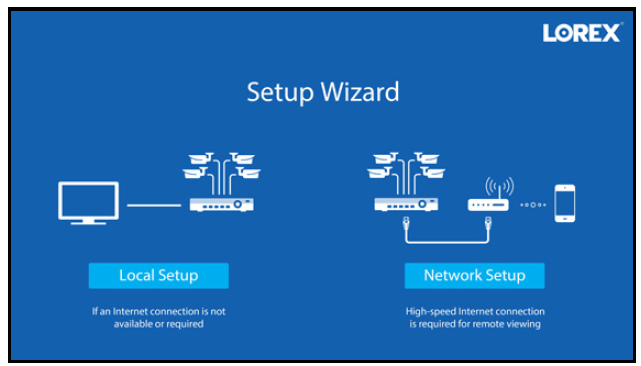
Lorex Fusion
Lorex Fusion supports connectivity with select wireless devices to the NVR. To learn more about fusion connectivity and which Lorex devices are compatible with this feature, visit lorex.com/pages/fusion.
Reference: Quick Access to System InformationTo quickly open a window that displays vital system information such as device ID, model number, firmware version, and IP address:
- Tap the button on the front panel of the recorder. OR
- Right-click to open the Quick Menu and click Info.
Need Help?Visit us online for up-to-date software and complete instruction manuals
- Visit lorex.com
- Search for the model number of your product
- Click on your product in the search results.
- Click on the Downloads tab.
Once you have completed all steps for initial setup on the front of this guide, please refer to the following sections to learn more about using your system.
Using the Mouse
NOTE: In live view, hover the mouse cursor over the top of the screen to open the Navigation Bar. Move the mouse cursor away from the top of the screen to close the Navigation Bar.
Using the Quick Menu
Right-click anywhere on the live viewing screen to open the Quick Menu.
a. Open Main Menu.b. Search and play back recordings.c. Control PTZ cameras (not included).d. Select camera/live display view.e. Add IP cameras over the LAN.f. Open manual recording controls.g. Preview faces detected in Live View.*h. Control auto focus cameras (not included).i. Adjust camera color and image settings.j. View system information.k. Start/stop sequence mode.l. Temporarily disable all current audible warnings.
* Compatible with select cameras only. Visit lorex.com/compatibility for details.
Adding Cameras from the LANFollow the steps below to add cameras that are not directly connected to the Power over Ethernet (PoE) ports on the back of the recorder.NOTE: Please visit lorex.com/compatibility for a list of compatible Lorex IP cameras.To add cameras from the LAN:
- Connect the camera to a router or switch on the same network as the recorder.
- Right-click and select Camera. If prompted, log in using the system user name (default: admin) and your new, secure password.
- Configure the following:
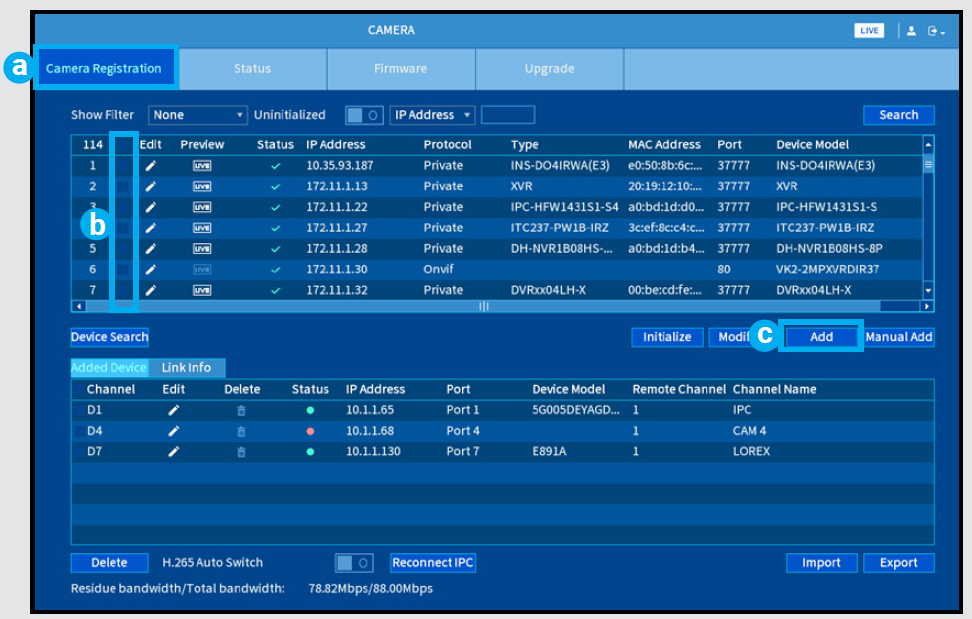
a. Click Camera Registration.b. Check the camera(s) you would like to add.c. Click Add. The status indicator turns green to show the camera is successfully connected.d. The added device(s) will appear in the Added Device list. Right-click to exit to live view.NOTE: If the icon in the Status column appears red, there may be a password issue with the camera. Select the camera and click Reconnect IPC.
Playback and SearchSearch through and play video recordings from the hard drive.
To search for and play recordings:
- From live view, right-click and then click Playback. If prompted, log in using the system user name (default: admin) and your new, secure password.
- Configure the following:

a. Use the calendar on the right to select the date to playback.b. Check channels you want to play back. Click the grey icon beside each selected channel to select Mainstream (M) or Substream (S) video quality.c. Click inside the video bar to select the playback time. Playback starts immediately at the selected time.
BackupBack up recordings from the hard drive to a USB flash drive (not included).
To back up recordings:
- Insert a USB flash drive (not included) into a free USB port on the recorder.
- From live view, right-click and then click Main Menu. If prompted, log in using the system user name (default: admin) and your new, secure password.
- Select BACKUP.
- Configure the following:

a. Select the channel(s) to search by.b. Select the type and quality of recordings to search for.c. Select a Start Time and End Time for your search.d. Choose a file format for your backed up files.e. Click Search to see recordings that match your search.f. Check boxes next to recordings you want to back up, then click Backup. You may also click Onekey Backup to back up all files that match your search.
Smart Motion Detection & Deterrence SettingsConfigure smart motion detection and/or active deterrence settings. For a complete list of compatible cameras, navigate to your recorder series at lorex.com/compatibility.
To configure smart motion detection or active deterrence:
- In live view, right-click and click Main Menu. If prompted, log in using the system user name (default: admin) and your new, secure password.
- Select EVENTS, then click Motion on the far left.
- In the Smd/Deterrence tab, configure the following:Option 1: Smart Motion Detection Cameras

a. Select the channel of a connected camera with person and vehicle detection.b. Check Enable underneath Person and/or Vehicle.c. Click Set next to Area to set active areas for person and/or vehicle detection. See Figure 1 below for details.d. Click Set next to Schedule to set a weekly schedule for person and/or vehicle detection. See Figure 2 below for details.e. Set preferences for the warning light and siren.f. Click Apply.
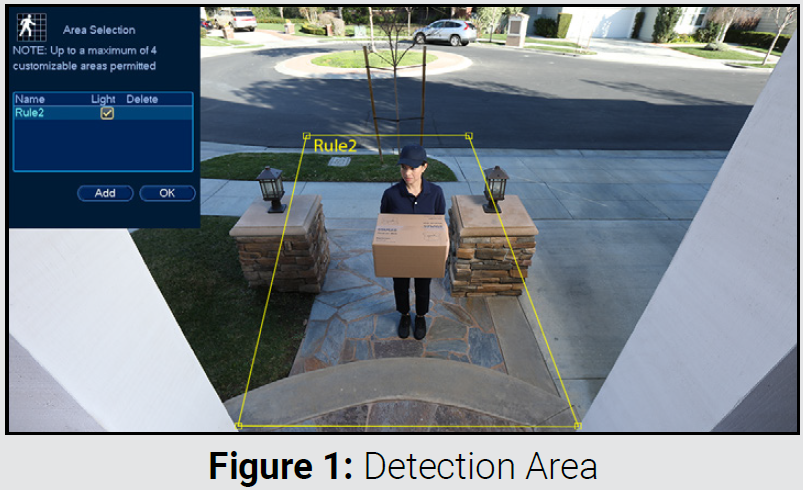
- Click Add to set an area for person or vehicle detection on the selected channel. Click-and-drag the corners to resize the area.
- For most accurate results, set an area where objects of interest will move within the bounding box as well as into / out of.
- Check Light next to a rule to flash the camera’s warning light when an object is detected.
- See your camera’s documentation for optimal camera positioning for person and vehicle detection.

- The default schedule, shown in Figure 2, is active during the night, between 5pm and 7am.
- Click Set to change the schedule for the corresponding day of the week.
- Click OK when finished.
Option 2: Active Deterrence Cameras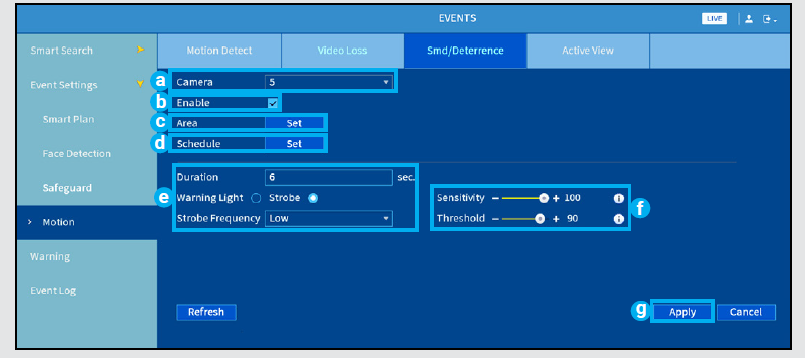
a. Select the channel of a connected deterrence camera.b. Check Enable.c. Click Set next to Area to set active areas for person and/or vehicle detection. See Figure 3 below for details.d. Click Set next to Schedule to set a weekly schedule for person and/or vehicle detection. See Figure 2 above for details.e. Set preferences for the warning light and siren.f. Set Sensitivity and Threshold levels to your preference.g. Click Apply.
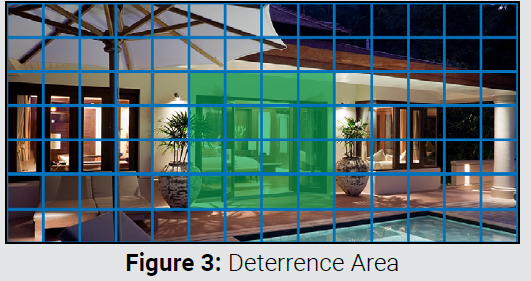
- The camera image appears with a grid overlay. The green area is the active area for deterrence.
- Click or click-and-drag to add / remove boxes from the active area.
- In Figure 3, only motion around the doorway will trigger the warning light.
- Right-click when finished.
Warning: To set off all connected deterrence cameras’ warning lights and sirens, press and hold the front panel button for 3 seconds.
Changing the Recorder’s Output ResolutionTo ensure the best possible picture quality, set the recorder’s output resolution to match the highest resolution supported by your monitor.
IMPORTANT: If you need to switch the monitor, make sure you set the recorder to an output resolution supported by the new monitor before switching.
To change the recorder’s output resolution:
- From live view, right-c lick and then click Main Menu. If prompted, log in using the system user name (default: admin) and your new, secure password.
- Click Display, then configure the following:
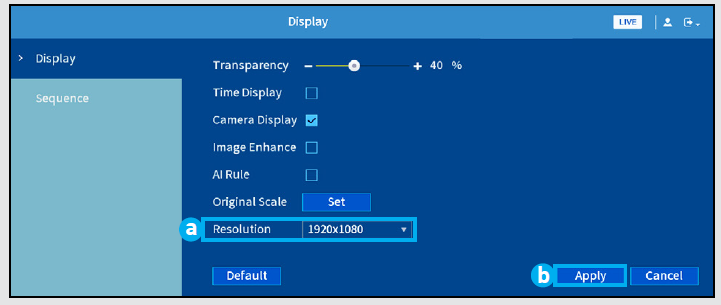
a. Set Resolution to match the highest resolution supported by your monitor. For example, select 3840×2160 for 4K monitors, or 1920×1080 for 1080p.b. Click Apply. The recorder will restart before changes take effect.
References
Lorex Fusion Collection | Lorex close newsletter hamburger mobile close triangle borderless arrow right arrow left arrow bottom arrow bottom arrow bottom arrow bottom arrow bottom arrow bottom arrow bottom arrow right arrow left arrow right arrow left phon
Product Compatibility Chart – Expand Your System | Lorex
Security Cameras – Home Security Camera Systems | Lorex
[xyz-ips snippet=”download-snippet”]

